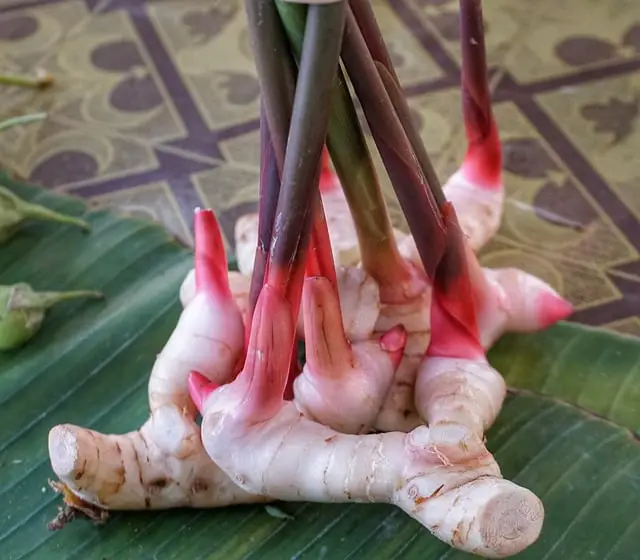Galangal is a root spice native to Southeast Asia, closely related to ginger. It has a unique, slightly sweet and peppery flavor, often used in Indonesian, Thai and Malaysian cuisine.
For an extra kick in your dishes, try the delicious taste of galangal. This versatile spice can be used in many different dishes for a zesty flavor boost.
Galangal Is A Versatile Spice
Galangal is a type of rhizome, or root, belonging to the ginger family. It’s similar in flavor to ginger and turmeric, but much spicier and with a distinct peppery taste. Its pungent aroma comes from its essential oils which range from sweet citrusy to eucalyptus-like flavors. This combination makes it the perfect addition to curries, soups, and casseroles.
Galangal can be used in a variety of dishes, including:
- Tom Yum soup
- Pad Thai noodles
- Green curry paste
- Massaman curry
- Satay marinade
- Stir-fries
- Seafood dishes
- Rice and noodle dishes
Why Galangal Isn’t A Well Known Spice
Galangal is not as well-known as other spices, such as ginger or turmeric, for several reasons:
- Regional Availability: Galangal is primarily used in Southeast Asian cuisine and is not as commonly used in other parts of the world. As a result, it may not be as easily available in some regions.
- Limited Exposure: Galangal is not as widely used or recognized as other popular spices, and many people may not have had the opportunity to try it or learn about its flavor and uses.
- Misidentification: Galangal can sometimes be confused with ginger, leading some people to believe that they are the same spice. However, the two are distinct and have different flavors and uses.
- Cultural Influence: The popularity of certain spices and flavors varies based on cultural traditions and preferences, and galangal may not be as well-known in some cultures as it is in others.
Despite these factors, galangal is increasingly gaining recognition and popularity among food lovers and home cooks, who appreciate its unique flavor and versatility in the kitchen.
How to Prepare Galangal for Cooking
To prepare galangal for cooking, you can follow these steps:
- Wash the galangal thoroughly to remove any dirt or debris.
- Peel the skin using a sharp knife or peeler.
- Slice the galangal into thin rounds, or mince it finely to a paste using a food processor or mortar and pestle.
- Store fresh galangal in the refrigerator in an airtight container for up to a week, or in the freezer for up to 3 months.
- Dried or powdered galangal can be stored in an airtight container in a cool, dark place for up to 6 months.
- When using dried or powdered galangal in a recipe, be aware that its flavor is more concentrated than fresh, so you may need to use less.
How to Cook with Galangal
To get the most out of the flavor, try adding galangal to dishes just before serving. This way, you can ensure that it retains its texture and fragrance. The tartness also makes it ideal for use in marinades or rubs as well.
When purchasing powdered forms, use small amounts since the flavor gets more intense with higher concentrations. A little goes a long way.
10 Dishes That Incorporate Galangal
- Tom Yum Soup: A spicy, sour and fragrant Thai soup made with galangal, lemongrass, kaffir lime leaves, chili, and shrimp or chicken.
- Pad Thai: A classic Thai stir-fry dish made with noodles, vegetables, and protein, flavored with galangal and other spices.
- Green Curry: A spicy Thai curry made with coconut milk, green chili, basil, and galangal, traditionally served with rice.
- Massaman Curry: A rich and flavorful Thai curry made with peanuts, potatoes, and galangal, served with rice.
- Satay: Skewered meat, usually chicken or beef, marinated in a mixture of galangal, lemongrass, and other spices, grilled and served with a peanut sauce.
- Stir-Fries: A variety of stir-fried dishes using galangal, such as Pad Kra Pao (stir-fried basil with meat and chili) or Pad See Ew (stir-fried noodles with soy sauce and vegetables).
- Seafood dishes: Galangal is often used to add flavor to seafood dishes such as steamed fish, seafood soup, and seafood curries.
- Rice and noodle dishes: Galangal is commonly used in Indonesian and Thai rice and noodle dishes, such as Nasi Goreng (fried rice) and Mee Goreng (fried noodles).
- Pork Ribs: Pork ribs slow-cooked in a sweet and savory sauce with galangal, chili, and other spices.
- Chicken Curry: Chicken cooked in a spicy, fragrant curry made with coconut milk, lemongrass, and galangal, served with rice.
Nutritional Information About Galangal
Galangal is a great source of essential vitamins and minerals. It’s also packed with antioxidants, which help protect the body from cell damage. This root is known to be effective in calming inflammation in the intestines due to its anti-inflammatory properties, as well as relieving digestive discomfort caused by stomach upset. It can even boost immunity by fortifying the gut against toxins.
Not only does galangal add a unique flavor to dishes, but it also offers a range of health benefits. Eating galangal can help reduce inflammation, ease digestive issues, boost the immune system and even protect against bacterial and fungal infections. Galangal is also associated with improved cognitive function and enhanced moods, making it an excellent addition to any meal.
Substitution Ideas
If you’re out of galangal, try substituting some other seasonings to achieve a similar flavor. Ginger is an obvious substitution, but turmeric and lemongrass are two other options that provide zesty bursts of flavor. Though they may not be as potent, they’ll give a hint of herbal brightness to the dishes you create.

